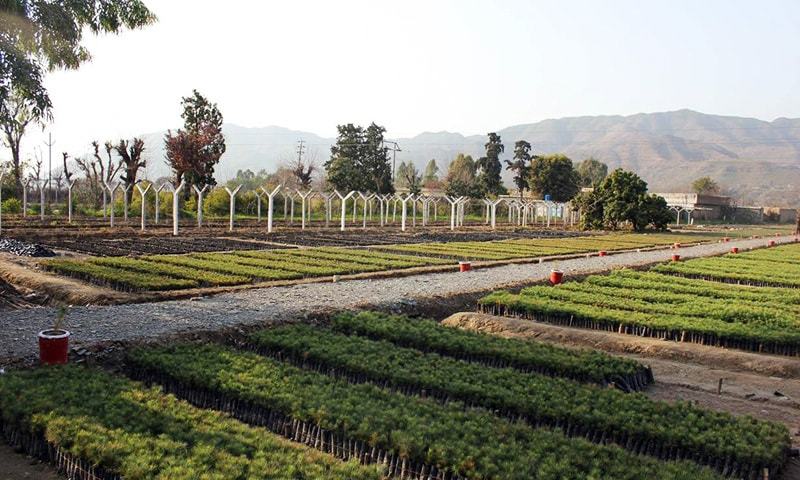KP's 'billion tree tsunami' successfully surging towards its goal
A view of a government-run tree nursery in Haripur, in Khyber Pakhtunkhwa.— Thomson Reuters Foundation
One of Pakistan's greenest provinces is becoming greener still: in just a year, Khyber Pakhtunkhwa has added three-quarters of a billion new trees, as part of a "tree tsunami" aimed at reversing worsening forest loss.
The success on the ground is phenomenal.
"This is not just about planting trees but about changing attitudes," said Rab Nawaz, senior director of programmes for WWF-Pakistan, which has helped audit the tree-planting effort.
The Billion Tree Tsunami, which involves adding trees both by planting and natural regeneration, is backed by Imran Khan's Pakistan Tehreek-i-Insaf (PTI).
It aims to turn around deforestation and increase the province's forested area by at least 2pc.
Years of tree felling have reduced Pakistan's forests to under 2pc of its land area, one of the lowest levels in the region, according to a 2015 UN Food and Agriculture Organisation report.
About 40pc of the country's remaining forests are in KP, where PTI's tree planting effort is expected to hit its billion-tree goal by the end of 2017.
Scaling up saplings
In preparation for the reforestation effort, the provincial government helped set up a network of tree nurseries across the province in 2016, providing loans and purchase agreements for tree saplings.
Altogether it has spent Rs11 billion ($110 million) on the effort, said Malik Amin Aslam, the chairman of the province's Green Growth Initiative.
About 13,000 government and private nurseries, in almost every district of the province, are now producing hundreds of thousands of saplings of local and imported tree varieties, including pines, walnuts and eucalyptus, Aslam told the Thomson Reuters Foundation.
The nurseries have provided about 40pc of the new trees in KP; the remaining trees have come from natural regeneration in forests now put under protection, he said.
Many small-scale nurseries, producing up to 25,000 saplings, have been set up with cash advances and a guaranteed purchase agreement from the provincial government.
Such small nurseries can earn incomes of around Rs12-15,000 a month, a sizeable income for rural villagers, said Aslam.
An estimated 500,000 green jobs have been created through the effort, some of which have gone to rural women and unemployed youth, he said.
"People have become aware that forests are KP's precious resource," he added.
Aslam said the regeneration effort is being monitored by both the provincial forest department and WWF-Pakistan, working as an auditor.
Nawaz, of WWF, said he had just returned from three days looking at 2.5 million new trees in the province. He called the restoration an amazing achievement by the government's forest department and by local communities who are paid to plant trees.
"Whether you support PTI or not, no one can deny that this is an environmental, economic and social success for other provinces to follow," he said.
Better tech and enforcement
The project is being monitored using modern technology. Last week Khan launched the project's website, which includes GPS coordinates of all the plantations and a live tree counter.
"This is a project for the future of Pakistan and something I keep very close to my heart. It is not only helping KP by providing a green, breathable environment and green jobs but is also building up Pakistan's much-needed defence against the high climate vulnerability that it faces," the cricketer-turned-politician told the the Thomson Reuters Foundation.
"It significantly contributes to the global efforts for sequestering carbon and mitigating climate change", Khan added.
To protect its forests, the PTI government has also enforced a complete ban on the cutting and felling of trees in reserved forests.
The government says the activities of the powerful "timber mafia" have been curtailed through dismantling more than 600 illegal sawmills and arresting more than 300 timber cutters, as well as issuing heavy fines.
"Two of our forest guards have been killed in timber encounters while many have braved injuries," Aslam said.
"All of these steps have forced the timber mafia on to the back foot and delivered a clear political message of ‘zero tolerance' to the illicit cutting of wood."
Effort goes nationwide
The project has been recognised by the Bonn Challenge, a global partnership aiming to restore 150 million hectares of the world's deforested and degraded lands by 2020.
The KP government – the only province to register under the Bonn Challenge, officials said – has committed to restore 380,000 hectares of forests and has already achieved nearly 80pc of that goal, Aslam said.
The Bonn challenge website estimates an economic benefit of the reforestation effort at $121m for the province, in terms of carbon sequestration, better watershed improvement and future sustainable wood supplies.
The project has proven so popular that the federal government has now begun implementing its own "Green Pakistan Programme".
The aim of the programme is to plant 100 million trees all over the country over the next five years.

























